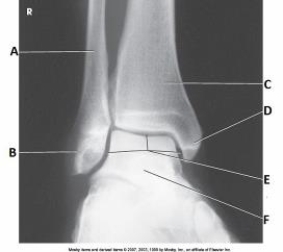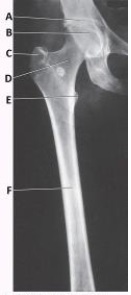A) 0 degrees.
B) 5 degrees cephalad.
C) 10 degrees cephalad.
D) 5 to 10 degrees cephalad.
Correct Answer

verified
Correct Answer
verified
Multiple Choice
To better demonstrate the TMT joint spaces of the foot, a posterior angulation of how many degrees is required?
A) 0
B) 10
C) 15
D) 20
Correct Answer

verified
Correct Answer
verified
Multiple Choice
What anatomy is labeled as letter E in the image below?

A) Sinus tarsi
B) Tibiotalar joint
C) Mortise joint
D) Medial malleolus
Correct Answer

verified
Correct Answer
verified
Multiple Choice
Which projections of the foot will best demonstrate the structural status of the longitudinal arch?
A) AP axial
B) AP oblique medial rotation
C) Lateral (lateromedial)
D) Lateral (lateromedial) weight-bearing
Correct Answer

verified
Correct Answer
verified
Multiple Choice
What is the position of the femoral condyles when the leg is properly positioned for an AP projection?
A) Perpendicular to the IR
B) Parallel to the IR
C) At a 15- to 20-degree oblique position (laterally)
D) At a 15- to 20-degree oblique position (medially)
Correct Answer

verified
Correct Answer
verified
Multiple Choice
How many degrees are the lower leg and foot rotated for the AP oblique projection of the toes in medial rotation?
A) 10 to 15
B) 20 to 25
C) 40 to 60
D) 30 to 45
Correct Answer

verified
Correct Answer
verified
Multiple Choice
The central-ray angulation for an AP oblique projection of the toes is:
A) 0 degrees.
B) 5 degrees posteriorly.
C) 10 degrees posteriorly.
D) 15 degrees posteriorly.
Correct Answer

verified
Correct Answer
verified
Multiple Choice
What is the central-ray angle for an AP projection of the femur?
A) 0 degrees
B) 5 degrees
C) 7 degrees
D) Variable-depending on body habitus
Correct Answer

verified
Correct Answer
verified
Multiple Choice
Often, the leg is too long to fit on one IR for radiographs. Which joint or joints should be included on the IR when the site of a lesion is known?
A) The ankle joint
B) The knee joint
C) Both joints on two IRs
D) The joint closest to the lesion
Correct Answer

verified
Correct Answer
verified
Multiple Choice
How many phalanges are in the great toe?
A) None
B) One
C) Two
D) Three
Correct Answer

verified
Correct Answer
verified
Multiple Choice
The two flat, superior surfaces of the tibia are called the:
A) tubercles.
B) malleoli.
C) condyles.
D) tibial plateaus.
Correct Answer

verified
Correct Answer
verified
Multiple Choice
The central-ray angle for a lateral projection of the ankle is:
A) 0 degrees.
B) 5 degrees cephalad.
C) 7 degrees cephalad.
D) 10 degrees caudad.
Correct Answer

verified
Correct Answer
verified
Multiple Choice
What anatomy is labeled with the letter C in the image below?

A) Greater trochanter
B) Lesser trochanter
C) Femoral head
D) Femoral neck
Correct Answer

verified
Correct Answer
verified
Multiple Choice
Which projections of the ankle are performed on a patient following an inversion or eversion injury?
A) AP and lateral
B) AP and both obliques
C) AP stress studies
D) AP, lateral, and both obliques
Correct Answer

verified
Correct Answer
verified
Multiple Choice
Which tarsal bone lies directly anterior to the talus?
A) Cuboid
B) Navicular
C) Medial cuneiform
D) Lateral cuneiform
Correct Answer

verified
Correct Answer
verified
Multiple Choice
Where is the central ray directed for an AP projection of the knee?
A) inch above the patellar base
B) inch above the patellar apex
C) inch below the patellar base
D) inch below the patellar apex
Correct Answer

verified
Correct Answer
verified
Multiple Choice
Where should the central ray be directed for a PA projection of the patella?
A) inch below the patella
B) Midpopliteal area
C) Base of the patella
D) Apex of the patella
Correct Answer

verified
Correct Answer
verified
Multiple Choice
The superior portion of the calcaneus contains a groove called the calcaneal sulcus. The inferior portion of the talus contains a matching groove called the sulcus tali. Collectively, these two sulci form the:
A) trochlea.
B) ankle mortise.
C) sinus tarsi.
D) sustentaculum tali.
Correct Answer

verified
Correct Answer
verified
Multiple Choice
How much is the knee flexed for a lateral projection?
A) 5 to 10 degrees
B) 15 to 20 degrees
C) 20 to 30 degrees
D) 30 to 45 degrees
Correct Answer

verified
Correct Answer
verified
Multiple Choice
On the anterior surface of the tibia is a prominent process called the:
A) body.
B) anterior border.
C) tibial tuberosity.
D) intercondylar eminence.
Correct Answer

verified
Correct Answer
verified
Showing 121 - 140 of 143
Related Exams